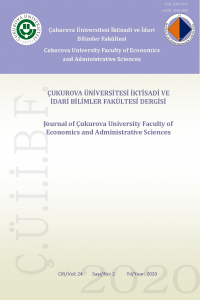Türkiye'de Enflasyon ve Enflasyon Belirsizliği: Kalman Filtre Yaklaşımı
Enflasyon, Enflasyon Belirsizliği, Kalman Filtre Analizi
Inflation and Inflation Uncertainty in Turkey: Kalman Filter Approach
Inflation, Inflation Uncertainty, Kalman Filter Analysis,
___
- Ball, L. (1992), “Why Does High Inflation Raise Inflation Uncertainty?” Journal of Monetary Economics, 29: 371-388.
- Barro, R. ve Gordon, D. (1983), “Rules, Discrection, and Reputation in a Model of Monetary Policy” Journal of Monetary Economics, 12: 101-123.
- Berument, H., Metin Özcan, K. ve Neyaptı, B. (2001), “Modelling Inflation Uncertainty Using EGARCH: An Application to Turkey” Tartışma Metni, Bilkent Üniversitesi, 6533.
- Bhar, R. ve Mallik, G. (2010), “Inflation, Inflation Uncertainty and Output Growth in the USA” Physica A: Statistical Mechanics and its Applications, 389 (23): 5503-5510.
- Caporale, G.M., Onorante, L. ve Paesani, P. (2009), “Inflation and Inflation Uncertainty in the Euro Area” CESifo Working Paper Series, 2720.
- Conrad, C. ve Karanasos, M. (2005), “On the Inflation-Uncertainty Hypothesis in the USA, Japan and the UK: A Dual Long Memory Approach” Japan and the World Economy, 17: 327–343.
- Cukierman, A. ve Meltzer, A. (1986), “A Theory of Ambiguity, Credibility, and Inflation Under Discretion and Asymmetric Information” Econometrica, 54 (5): 1099-1128.
- Dickey, D.A. ve Fuller, W.A. (1979), “Distribution of the Estimators of Autoregressive Time Series with a Unit Root” Journal of the American Statistical Association, 74: 427-431.
- Erdoğan, S. ve Bozkurt, H. (2004), “Türkiye’de 1983-2003 Döneminde Enflasyon ile Enflasyon Belirsizliği İlişkisi”, İktisat İşletme ve Finans, 19: 62-71.
- Erkam, S. (2008), “Enflasyon ve Enflasyon Belirsizliği: Türkiye Örneği” Sosyo- Ekonomi, 4(7): 157-174.
- Evans, M. ve Wachtel, P. (1993), “Inflation Regimes and Sources of Inflation Uncertainty” Journel of Money, Credit and Banking, 25: 475-511.
- Friedman, M. (1977), “Nobel Lecture: Inflation and Unemployment” Journal of Political Economy, 85(3): 451-472.
- Fischer, S. ve Modigliani, F. (1978), “Towards and Understanding of the Real Effects and Costs of Inflation” Review of World Economics, 114: 810–833.
- Fountas, S. (2001), “The Relationship between Inflation and Inflation Uncertainty in the UK: 1885–1998” Economics Letters, 74(1): 77–83.
- Fountas, S., Ioannidis, A. ve Karanasos, M. (2004), “Inflation, Inflation-Uncertainty, and a Common European Monetary Policy” The Manchester School, 72(2): 221–242.
- Granger, C.W.J. (1969), “Investigating Causal Relations By Econometric Models and Cross-Spectral Methods” Econometrica, 37(3): 424-438.
- Grier, K. ve Perry, M. (1998), “On Inflation and Inflation Uncertainty in the G7 Countries” Journal of International Money and Finance, 17: 671-689.
- Holland, A. S. (1984), “Does Higher Inflation Lead More Uncertain Inflation?” Federal Reserve Bank of St. Louis Review, 15-26.
- Holland, A. S. (1995), “Inflation and Uncertainty: Tests for Temporal Ordering” Journal of Money, Credit, and Banking, 27: 827-837.
- Hwang, Y. (2001), "Relationship Between Inflation Rate and Inflation Uncertainty" Economic Letters, 73: 179-186.
- Jiranyakul, K.ve Opiela, T.P. (2010), “Inflation and Inflation Uncertainty in the ASEAN-5 Economies” Journal of Asian Economics, 21: 105-112.
- Kalman, R. E. (1960), “A New Approach to Linear Filtering and Prediction Problems” Journal of Basic Engineering, 82: 34-45.
- Karanasos, M. ve Schurer, S. (2008), “Is the Relationship Between Inflation and Its Uncertainty Linear?” German Economic Review, 9(3): 265-286.
- Kontanikos, A. (2004), “Inflation and Inflation Uncertainty in the UK Evidence from GARCH Modelling” Economic Modelling, 21(3): 525–543.
- Korap, L. ve Saatçioğlu, C. (2009), “New Time Series Evidence for the Causality Relationship Between Inflation and Inflation Uncertainty in the Turkish Economy” MPRA, 10(2): 235-248.
- Logue, D. ve Willett, T. (1976), “A Note on the Relation Between the Rate and Variability of Inflation” Economica, 43: 151–58.
- Lucas, R.E. (1973), “Some International Evidence on Output-Inflation Tradeoffs” American Economic Review, 63: 126-132.
- Maravall, A. (2005) “An Application of the TRAMO-SEATS Automatic Procedure; Direct Versus Indirect Adjustment”, Banco de Espana, Documentos de Trabajo, No: 0524.
- Okun, A. (1971), “The Mirage of Steady State Inflation” Brookings Papers on Economic Activity, 2: 485-498.
- Omay, T. (2008), “Enflasyon ve Büyüme Belirsizliklerinin Enflasyon ve Büyüme ile Olan İlişkileri: Türkiye Örneği” Çankaya Üniversitesi Fen-Edebiyat Fakültesi Dergisi, 10: 81-108.
- Özdemir, Z. A. ve Fisunoğlu, M. (2008), “On the Inflation-Uncertainty Hypothesis in Jordan, Philippines and Turkey: A Long Memory Approach” International Review of Economics and Finance, 17: 1–12.
- Özer, M. ve Türkyılmaz, S. (2005), “Türkiye’de Enflasyon ile Enflasyon Belirsizliği Arasındaki İlişkinin Zaman Serisi Analizi” İktisat İşletme ve Finans, 20: 93– 104.
- Pourgerami, A. ve Maskus, K. (1987), “The Effects of Inflation on the Predictability of Price Changes in Latin America: Some Estimates and Policy Implications” World Development, 15(2): 287-290.
- Telatar, F. (2003), “Türkiye’de Enflasyon, Enflasyon Belirsizliği ve Siyasi Belirsizlik Arasındaki Nedensellik İlişkileri” İktisat İşletme ve Finans, 18(203): 42–51.
- Thornton, J. (2007), “The Relationship between Inflation and Inflation Uncertainty in Emerging Market Economies” Southern Economic Journal, 73(4): 858-870.
- Thornton, J. (2008), “Inflation and Inflation Uncertainty in Argentina, 1810–2005” Economics Letters, 98: 247–252.
- Türkyılmaz, S. ve Özer, M. (2010), “MGARCH Modelling of the Relationship Among Inflation, Output, Nominal and Real Uncertainty in Turkey” MIBES Transactions, 4(1): 125-137.
- Yamak, R. (1996), “Türkiye’de Enflasyon ve Enflasyon Belirsizliği” İşletme ve Finans, 11(121): 37-46.
- ISSN: 1300-3747
- Başlangıç: 1987
- Yayıncı: Çukurova Üniversitesi
Şükran Karaca YILMAZ, Mustafa GÜLMEZ
Türkiye'de Enflasyon ve Enflasyon Belirsizliği: Kalman Filtre Yaklaşımı
Havvanur Feyza ERDEM, Rahmi YAMAK
Yeni Anayasacılık ve Uluslararası Sermaye Hareketlerinin Anayasallaştırılması
2000 Sonrası Türkiye’de Kırsal ve Kentsel Yoksulluk: Kırsal Yoksullukla Mücadele Uygulama Örnekleri
Harun YAKIŞIK, Berna Şafak ZÜLFİKAR
Türkiye’de İller Düzeyinde Karayolu Yük Trafiği Dağılımının Analizi
Yusuf BAYRAKTUTAN, Mehmet ÖZBİLGİN
Maddi Duran Varlıklarda Amortisman Uygulamalarının TMS 16 ve Vergi Mevzuatı Açısından İncelenmesi
Zaman Pencereli Araç Rotalama Problemine Tasarruf Yöntemi ile Bir Uygulama
Metasezgisel Yöntemler ve Uygulama Alanları
Bilişim Sektöründen Pazarlamaya Aktarılan Yeni Bir Kavram: Çevik Pazarlama
İran’ın Raşt Büyükşehrinde Ekonomik, Sosyal ve Coğrafi konular Üzerinde Bir Araştırma
